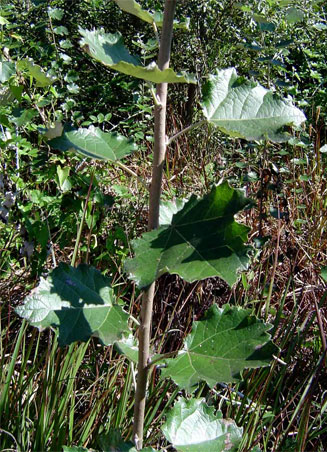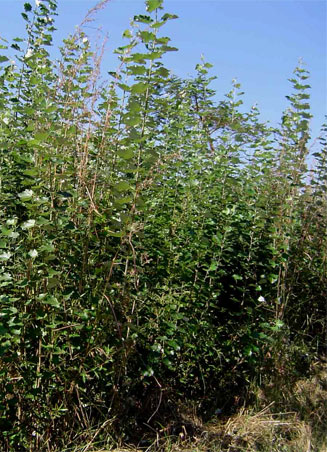Populus x canescens (Grey poplar)
Life
> eukaryotes >
Archaeoplastida >
Chloroplastida
>
Charophyta > Streptophytina > Plantae (land plants)
> Tracheophyta (vascular plants) > Euphyllophyta > Lignophyta (woody plants)
> Spermatophyta (seed plants) > Angiospermae (flowering
plants) > Eudicotyledons > Core Eudicots > Rosids >
Eurosid I > Order: Malpighiales
> Family:
Salicaceae > Genus: Populus
 |
 |
|
Populus x canescens, Greystone Park
National Park, Harare, Zimbabwe. [photos Bart Wursten ©, Flora of Zimbabwe] |
Identification
A hybrid between
Populus alba and Populus tremula. It is similar in
appearance to Populus alba
mainly in that they both have lobed leaves with young leaves having
a tomentum (woolly covering) on the underside of the leaves. They
can be distinguished on the basis of the following leaf characters:
| |
Populus alba |
Populus x canescens |
| Leaf size |
Usually longer than 45 mm |
Usually smaller, shorter than 40 mm |
| Leaf shape |
1-5 lobed and have more than 5 small,
irregular, sharp, triangular teeth on each side. |
Lobes reduced to 4 or 5 coarse, broadly
rounded teeth on each side. |
| Underside of leaf |
Old leaves have a tomentum (i.e. have
dense, matted hairs on underside) |
Old leaves without a tomentum (i.e. don't
have dense, matted hairs) |
Distribution and habitat
Native to Europe and Western Asia. In southern
Africa, it has become naturalised along streams and rivers in
Limpopo, North-West Province, Mpumalanga, Gauteng, Free State,
KwaZulu-Natal, Northern Cape, Western Cape and Eastern Cape. It was
introduced to southern Africa to supply wood for the match industry
but Populus deltoides is now favoured for this purpose.
There are only male plants in southern Africa and they spread
vegetatively by root suckers.
References
- Jordaan, M. 2005. FSA contributions 18: Salicaceae s. str.
Bothalia 35(1): 7-20.
Text by Hamish Robertson |
